Students who joined the PKM (Students Creativity Unit) team -Cipta Karsa Faculty of Engineering, Yogyakarta State University have the idea to make Termo Roof Panel, a technological innovation solar thermal collectors that converts heat into electrical energy (solar heat harvester) based on phase change material as a solution to overcome the energy crisis in Indonesia.
Mohamad Dirgantara Nurul Galaksi, one member of the group explained that the basic design of the Termo Roof Panel is that it utilizes solar thermal energy which is then converted into electrical energy with the aid of phase change material, phase change material used is the type of paraffin organic that will be joined into the roof panels in the form of tiles made of metal," he said.
Furthermore, Dirgantara explained that this Termo Roof Panel serves to harness solar thermal energy in order to optimize the natural energy provided on earth. In addition to be used as energy, Termo Roof Panels can also function as the roof of the building, so that in one tool contains two benefits that can be utilized directly.
Moreover, aspects of the materials used in the form of phase change materials (PCM) that can store energy and are not only used to heat a fluid, but also able to maintain the temperature of a fluid to remain constant. Another component of Termo Roof Panel is a Thermoelectric Generator (TEG) tool that can be used for generating electrical voltage by utilizing the conductivity or thermal conductivity of a metal plate.
The team members are Arizka Setya Windhiarti, Riyan Sugiarto, Dyah Ayu Pratiwi, Nida Arifatul Hasanah, dan Mohamad Dirgantara Nurul Galaksi. Further, Dirgantara explained how Thermoelectric Generator (TEG) by means of heat entrance on one side and the other side and then removed from the heat transfer generates a thermoelectric voltage passing through the connection and the magnitude of the voltage produced that is proportional to the temperature gradient.
"The working principle of Termo Roof Panel is to absorb the heat of the earth and then absorbed by the panel and PCM heat that has accumulated forwarded by TEG is converted into electricity by means of connecting cables at the Thermoelectric generators that are connected one by one in series with a cable," Dirgantara continued.
"This is done so that the electric current obtained can be collected in one point and after the currents come together in one point, then the current or the electrical power obtained is stored in a battery. Besides stored in batteries, electric current can be channeled directly to the use of household needs by converting the DC current into AC using an inverter, "said Dirgantara.
The Termo Roof panel is environmentally friendly because it does not generate pollution such that of fossil fuels that were used, as well as energy conservation for Termo Roof Panels role in the management of energy conservation through electricity energy savings, especially in Indonesia, which experiences a power crisis, "added by the member of the group, Arizka.
"In addition, Termo Roof Panel is the processing of waste, since one of its components is a waste plate or zinc. This attempt is intended to support the government's efforts to reduce the level of waste generation in Indonesia, another advantage is space-saving and more efficient," Arizka added.
"So our expectations with the Termo Roof Panel technological innovation of solar thermal collectors into electrical energy can help reduce the energy crisis that occurs in Indonesia today", she hoped. (haryo





